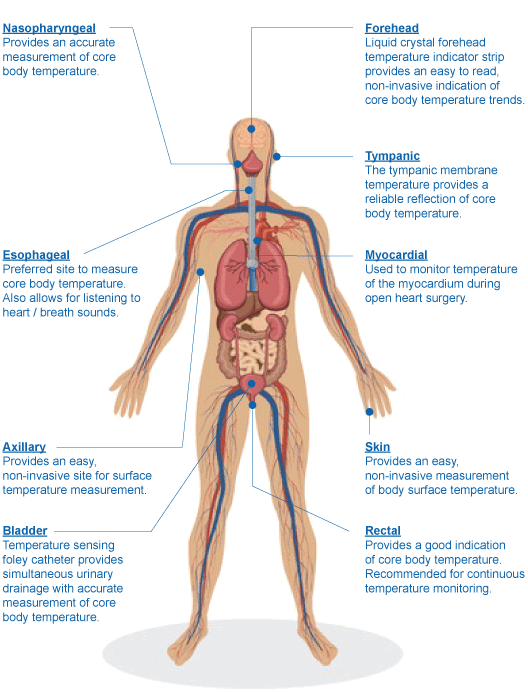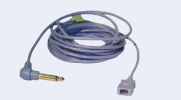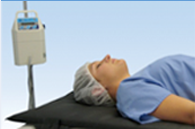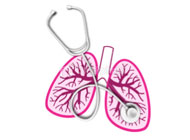Customer Service
 US: 800-425-3535
US: 800-425-3535
 International: +1 914-789-2100
International: +1 914-789-2100
The Importance of Monitoring Patient Temperature
The human body requires a nearly constant internal temperature to maintain healthy metabolic function. Under normal circumstances, the thermoregulatory system maintains core temperature within 0.2˚C of 37˚C, or normothermia. General anesthetics inhibit thermoregulation causing significant deviations from normal body temperature.
As a result, all patients under anesthesia, regardless of age, weight or other factors, are at increased risk of hypothermia and/or hyperthermia. Precise temperature monitoring is critical to preventing the serious complications associated with these conditions.
Patient Temperature Monitoring Sites

Potential Risks – the Importance of Maintaining Normothermia
Perioperative hypothermia, defined by a core body temperature below 36˚C, can occur rapidly in anesthetized patients. The reason for this is, in addition to inhibiting the body’s ability to generate and retain heat, general anesthetics cause vasodilation – widening of the blood vessels. This allows warmer blood to flow from the core to the periphery, resulting in significant heat loss to the core.
As a result of this redistribution of heat, the patient’s core temperature drops between 1˚ to 1.5˚C within the first hour following induction of anesthesia. The numerous adverse effects of hypothermia are well documented and include impaired blood coagulation, increased risk of surgical site infection, potential morbid myocardial events, and delayed wound healing resulting in longer hospital stays.
Preventing Perioperative Hypothermia
Hypothermia can be prevented by vigilant patient temperature monitoring and use of an active patient warming system. The Surgical Care Improvement Project (SCIP) mandates that all patients under anesthesia for one hour or longer must be actively warmed to maintain normothermia (Learn more about NOVAMED USA’s KOALA reusable underbody warming system and the SCIP Initiative).
Effects of Malignant Hyperthermia
Malignant hyperthermia is an inherited condition often triggered by an allergic reaction to certain anesthetics. Defined by a sudden rapid increase in patient temperature, this condition impairs the body’s ability to thermoregulate, supply oxygen and remove carbon dioxide, leading to circulatory collapse and death if not treated quickly.
Precise temperature monitoring is critical to the detection and early treatment of hyperthermia. If surgeons notice a sudden increase in patient temperature, they can respond with treatment before irreversible damage occurs.
Learn more about NOVAMED USA temperature monitoring products to address a variety of clinical applications:
• LIFESOUND Esophageal Stethoscopes
• NOVATEMP Skin Temperature Sensors
• NOVATEMP Foley Catheter with Temperature Sensor
For improved airway management, NOVAMED USA offers the most complete selection of laryngoscopes available.
• NOVALITE Fiber Optic Laryngoscopes
• NOVALITE MRI Conditional Fiber Optic Laryngoscopes
• NOVALITE LED BRITE Standard Laryngoscopes
Discover KOALA Warming System, the ONLY SCIP approved, underbody patient warming to prevent perioperative hypothermia. KOALA is a reusable, cost efficient “go green” alternative to forced air / circulating water warming systems.

All NOVAMED Temperature Monitoring Products are Latex Free.
 Match your temperature cable requirements according to the physiological monitor utilized. Choose from the complete selection of reusable adapter cables NOVAMED offers.
Match your temperature cable requirements according to the physiological monitor utilized. Choose from the complete selection of reusable adapter cables NOVAMED offers.
NOVATEMP Dual Display Temperature Monitor is a portable, battery operated solution for an accurate temperature measurement. Ideal for critical care scenarios requiring on-the-go temperature monitoring.

The SCIP Initiative has defined temperature as a critical variable in patient care, correlating the prevention of perioperative hypothermia with improved recovery rates and the prevention of Surgical Site Infections. As a result, greater emphasis is placed on temperature monitoring and patient warming.
KOALA ∆T Warming System utilizes SCIP approved “air free” conductive warming technology to promote normothermia.

